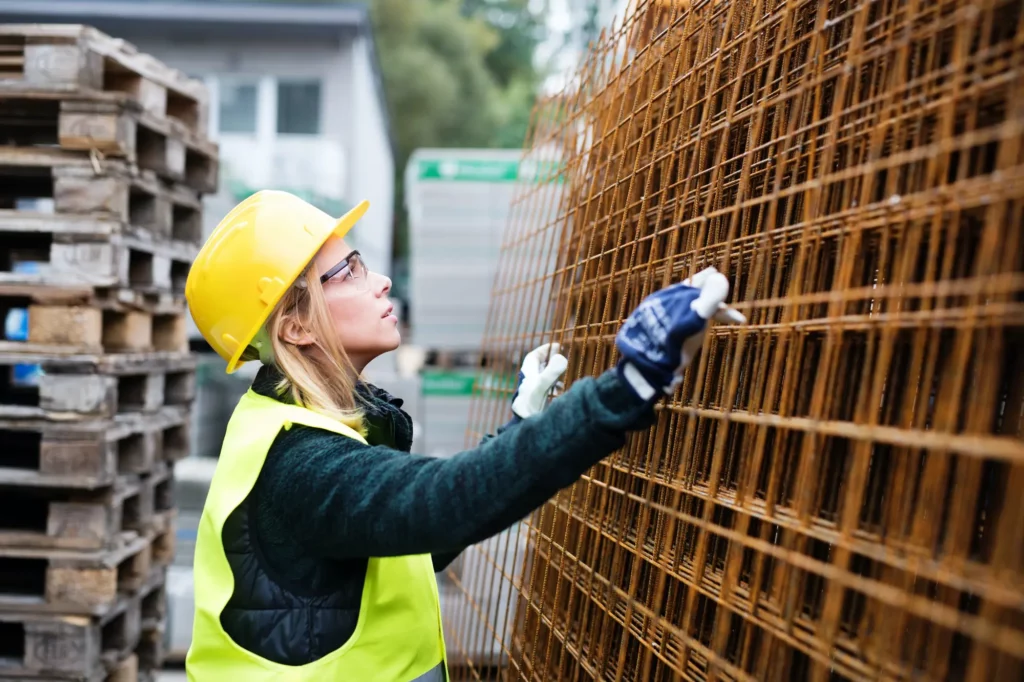Safe handling and proper installation of rebars are crucial for construction site safety and the strength of structures. These steel reinforcement bars are essential for concrete buildings, as they determine how strong and long-lasting they will be.
Working with rebars comes with its own set of challenges and risks. If not handled correctly, it can result in:
- Physical injuries from sharp ends and heavy loads
- Weakening of structures due to incorrect installation
- Damage to materials that require expensive replacements
- Delays in projects caused by safety incidents
This guide will teach you the best practices for safely handling and installing rebars. It includes practical techniques based on industry knowledge and Australian construction standards. We will cover important topics such as using personal protective equipment (PPE) correctly, storing rebars properly, lifting them safely, and installing them according to guidelines.
Whether you have years of experience in construction or are just starting out with reinforced concrete work, these guidelines will help you maintain safety standards while achieving the best results for your structures. Each section contains specific steps that you can easily implement on your construction site right away.

What Are Rebars and Why Are They Critical in Construction?
Reobars, short for reinforcing bars, are steel rods designed to strengthen concrete structures. These metal bars create a robust internal skeleton that transforms ordinary concrete into reinforced concrete, capable of withstanding substantial loads and stresses.
The Science Behind Rebar Strength
Concrete excels at handling compression forces but struggles with tension. Rebars address this limitation by:
- Absorbing tensile forces that would crack plain concrete
- Creating a composite material that resists bending and flexing
- Preventing structural failures under heavy loads
- Distributing weight evenly throughout the concrete mass
Types of Rebars in Australian Construction
Different construction projects demand specific rebar types:
- Standard Carbon Steel Rebars – Most common, suitable for general construction
- Epoxy-Coated Rebars – Ideal for coastal buildings
- Stainless Steel Rebars – Used in corrosive environments
- Galvanised Rebars – Perfect for underground structures
Find more on: LVL Construction Beams: Applications Beyond Formwork
Size Classifications
Rebars come in various diameters, marked by distinct patterns:
- F14 – Lighter grade, suited for residential projects
- F17 – Heavy-duty grade for commercial construction
- Custom sizes – Available for specialised applications
The selection of appropriate rebar type and size directly impacts structural integrity. A building’s load requirements, environmental conditions, and intended use guide the choice of reinforcement. This careful consideration ensures the concrete structure maintains its strength and durability throughout its service life.
What Personal Protective Equipment (PPE) Is Essential for Safe Handling of Rebars?
Working with rebars requires specific safety gear to protect against common hazards like cuts, impacts, and falling objects. Your safety equipment must include:
Essential PPE for Rebar Handling:
- Heavy-duty gloves – Cut-resistant gloves with reinforced palms protect against sharp edges and prevent hand injuries
- Safety glasses or face shields – Shield eyes from metal fragments, rust particles, and concrete dust
- Hard hat – Protects against falling objects and head injuries during lifting operations
- Steel-toe boots – Prevent foot injuries from dropped rebars and provide stability on uneven surfaces
- High-visibility clothing – Ensures workers remain visible to equipment operators and other team members
- Long-sleeve shirts and full-length trousers – Protect arms and legs from cuts and abrasions

Additional Protection Requirements:
- Wear impact-resistant knee pads when working at ground level
- Use respiratory protection when cutting or grinding rebars
- Select weather-appropriate PPE for outdoor work conditions
Your PPE must be properly fitted and regularly inspected for damage. Replace worn or damaged equipment immediately to maintain protection levels. Construction supervisors should conduct daily PPE checks before work begins to ensure compliance with safety standards. Find more about safety on https://pmc.ncbi.nlm.nih.gov/articles/PMC7768411/
The Australian construction industry reports that proper PPE use reduces rebar-related injuries by up to 85%. Workers must understand that skipping even one piece of protective equipment can lead to serious injuries.
How Should Rebars Be Stored and Maintained On-Site to Prevent Damage and Corrosion?
Proper storage of rebars directly impacts their performance and longevity in concrete structures. You need specific measures to protect these vital construction materials from environmental damage.
Essential Storage Requirements:
- Store rebars on raised platforms at least 300mm above ground level
- Use timber bearers or concrete blocks as support points
- Keep different rebar sizes separated and clearly labelled
- Cover stored rebars with waterproof materials during wet weather
- Ensure adequate ventilation to prevent moisture accumulation
Rust poses a significant threat to rebar integrity, particularly in coastal construction sites. When rust forms, it expands up to 10 times the original steel volume, creating internal pressure that can crack concrete structures. Salt-laden air accelerates this corrosion process, making proper storage critical in maritime environments.
Protective Measures Against Corrosion:
- Clean rebars thoroughly before storage
- Apply rust-inhibiting solutions to exposed surfaces
- Store away from chemical substances and salt spray
- Maintain organised stock rotation to prevent prolonged exposure
Coated rebars offer enhanced protection against corrosion. Epoxy-coated options provide a protective barrier against moisture and chemicals, while hot-dip galvanised rebars create a zinc coating that sacrificially corrodes to protect the underlying steel. These specialised options prove particularly valuable in aggressive environments where standard rebars might deteriorate rapidly.
Storage Area Requirements:
- Level, well-drained ground
- Protection from vehicle traffic
- Easy access for inspection
- Clear identification systems
- Sufficient space between bundles for air circulation
What Are the Best Practices for Lifting and Moving Rebars Safely on Site?
Safe handling of rebars requires specific techniques to protect workers from potential injuries. Here’s how you can implement proper lifting methods:
Manual Handling Guidelines:
- Keep your back straight and bend at the knees when lifting
- Hold rebars close to your body during transport
- Use mechanical aids for bundles weighing over 20kg
- Work in pairs when handling longer bars (6+ metres)
- Avoid twisting movements while carrying loads
Equipment and Tools:
- Use crane-mounted lifting chains for heavy bundles
- Install proper rigging points at designated lifting areas
- Deploy mobile trolleys for horizontal transport
- utilise rebar carrying hooks for single-person operations
Workspace Organisation:
- Clear pathways of obstacles and debris
- Designate specific walking routes for material transport
- Install adequate lighting in storage and work areas
- Mark out safe zones for rebar placement
- Keep cutting and bending areas separate from main walkways
Load Assessment:
- Check bundle weight before attempting to lift
- Inspect binding wires and supports
- Assess the route’s condition and potential hazards
- Consider weather conditions affecting grip
- Plan rest points for long-distance carries
Team Coordination:
- Use clear hand signals during team lifts
- Establish verbal commands for synchronised movements
- Assign a lead person for coordinated lifting
- Rotate lifting duties among team members
- Brief all workers on the day’s lifting plan
How Should Workers Understand Construction Plans Before Installing Rebars?
Reading construction plans accurately determines the success of rebar installation projects. A thorough understanding of these technical documents helps prevent costly mistakes and ensures structural integrity. Click here to find more about prevent.
Essential Elements to Review:
- Bar sizes and grades specified for different structural components
- Spacing requirements between parallel bars
- Cover dimensions from concrete surface to rebar
- Lap splice locations and lengths
- Hook details and bend specifications
- Support chair positions and heights
Critical Measurements:
- Vertical spacing in walls (typically 48 inches)
- Horizontal spacing in slabs
- Minimum concrete cover requirements
- Development lengths at connections
You need to identify specific zones requiring additional reinforcement, such as around openings or at stress concentration points. Pay close attention to the scale indicated on drawings – a small measurement error can lead to significant deviations in the actual structure.
Check for any site-specific requirements or special considerations noted in the specifications. These might include:
- Exposure conditions affecting concrete cover
- Seismic design requirements
- Load-bearing capacities
- Special inspection points
The ability to visualise the 3D arrangement from 2D drawings helps ensure proper placement and avoid interference with other building elements like electrical conduits or plumbing systems.
How Should Rebars Be Installed to Maximise Concrete Strength?
Proper rebar installation directly impacts the structural integrity of concrete elements. Here’s a detailed guide to achieving maximum concrete strength through correct rebar placement:
1. Positioning and Support
- Place chairs or spacers at regular intervals to maintain proper concrete cover
- Secure rebars firmly to prevent displacement during concrete pouring
- Use wire ties at intersections to create a stable reinforcement cage
2. Spacing Requirements
- Vertical walls: Install bars every 48 inches (1200mm)
- Horizontal slabs: Space bars at 16 inches (400mm) centres
- Allow minimum 1-inch (25mm) clearance between parallel bars
- Maintain 2-inch (50mm) concrete cover for external exposure
3. Lap Length Guidelines
- Calculate lap lengths as 40 times the bar diameter
- Stagger lap joints to avoid stress concentration
- Ensure proper overlap alignment for force transfer
4. Pre-Pour Checklist
- Clean rebars thoroughly to remove loose rust or debris
- Check bar sizes match specifications
- Verify correct positioning of splices and bends
- Ensure adequate support for top bars in deep sections
5. Concrete Pour Considerations
- Pour concrete in layers to prevent segregation
- Vibrate concrete carefully around rebars
- Monitor rebar positions during pouring
- Avoid direct vibrator contact with reinforcement
These installation practices create optimal bonding between concrete and reinforcement, resulting in superior structural performance and durability.
What Safety Measures Should Be Taken During Rebar Installation?
Rebar installation presents specific hazards that require careful attention and preventive measures. Workers face risks from sharp ends, heavy materials, and unstable structures during the installation process.
Essential Safety Protocols:
- Cap exposed rebar ends with protective mushroom-shaped covers
- Install guardrails around rebar mat edges to prevent falls
- Secure loose bars to prevent shifting during concrete placement
- Use proper lifting techniques when handling heavy rebar bundles
- Keep work areas clear of trip hazards and debris
Critical Protection Measures:
- Install temporary wooden platforms over horizontal rebar mats
- Bend protruding vertical bars into hooks when practical
- Set up designated walkways through rebar installations
- Maintain proper spacing between workers during installation
- Use tag lines when lifting rebar bundles with cranes
Site-Specific Considerations:
- Create exclusion zones during overhead work
- Position first aid stations within easy reach
- Post clear signage indicating rebar work areas
- Establish emergency response procedures
- Schedule regular safety briefings for installation teams
These safety measures protect workers from common hazards like impalement, falls, and crushing injuries. Regular safety audits help ensure compliance with these protective measures throughout the installation process.
How Can Post-Installation Inspections Ensure Quality and Safety?
Post-installation inspections serve as critical quality control checkpoints in rebar construction. These inspections identify potential issues before concrete pouring begins, preventing costly repairs and structural compromises.
A thorough post-installation inspection includes:
- Spacing verification – Measuring gaps between parallel bars to ensure compliance with design specifications
- Cover checks – Confirming sufficient concrete coverage around rebars
- Tie inspection – Examining wire ties for proper tightness and spacing
- Alignment assessment – Verifying bars are straight and positioned correctly
- Cleanliness review – Checking for debris, oil, or other contaminants that could affect concrete bonding
Professional inspectors use specific tools during these assessments:
- Tape measures for spacing verification
- Cover meters to check concrete depth
- Digital cameras for documentation
- Inspection checklists
Regular documentation of inspection findings creates a valuable record for future reference and compliance requirements. These records help track patterns in installation quality and identify areas needing additional training or process improvements.
Quality inspections also reveal potential safety hazards like:
- Improperly secured bars that could shift during concrete pouring
- Missing protective caps on exposed ends
- Inadequate support systems
- Compromised coating on specialised rebars
What Maintenance Practices Help Prolong The Life Of Installed Rebars?
Regular maintenance checks protect your rebar investment and ensure structural integrity. A systematic approach to rebar maintenance includes:
1. Visual Inspections
- Check for surface rust spots every 3-6 months
- Look for concrete cracks near rebar locations
- Document any discolouration or scaling
- Photograph areas of concern for tracking changes
2. Protective Measures
- Apply waterproof sealants to concrete surfaces
- Maintain proper drainage around structures
- Clean exposed rebar surfaces with wire brushes
- Remove any accumulated debris or moisture
3. Environmental Monitoring
- Test pH levels in surrounding concrete
- Measure chloride content in coastal environments
- Track exposure to de-icing salts
- Record temperature fluctuations
4. Professional Assessment
- Schedule annual structural engineer inspections
- Use non-destructive testing methods
- Conduct strength assessments
- Implement corrosion monitoring systems
The key to effective rebar maintenance lies in early detection and swift response to potential issues. Creating a detailed maintenance log helps track deterioration patterns and guides preventive actions.
How Do Different Types Of Coated Rebars Enhance Durability?
Coated rebars serve as a crucial defence against corrosion in challenging environments. Each coating type offers specific advantages for different construction scenarios:
1. Epoxy-Coated Rebars
- Creates an impermeable barrier against moisture and chemicals
- Ideal for bridge decks and marine structures
- Extends service life by up to 40 years
- Requires careful handling to prevent coating damage
2. Hot-Dip Galvanised Rebars
- Zinc coating bonds metallurgically with steel
- Self-heals minor scratches and damage
- Performs well in moderately aggressive environments
- Cost-effective for long-term durability
3. Stainless Steel Rebars
- Premium solution for extreme exposure conditions
- Resistant to chloride-induced corrosion
- Suitable for coastal structures and chemical plants
- Higher initial cost offset by minimal maintenance needs
4. Glass Fibre Reinforced Polymer (GFRP) Rebars
- Complete immunity to electrochemical corrosion
- Lightweight and high tensile strength
- Perfect for MRI rooms and marine applications
- Non-conductive properties benefit specific projects
The selection of coated rebars depends on exposure conditions, project lifespan, and budget constraints. Coastal projects benefit from stainless steel or epoxy coatings, while inland structures might find galvanised options more cost-effective. GFRP rebars excel in specialised applications where corrosion resistance and non-magnetic properties are essential.
Conclusion
Safe handling and proper installation of rebars are essential for successful construction projects. The practices outlined in this guide protect both workers and the integrity of the structure:
- Thorough understanding of construction plans
- Consistent use of appropriate PPE
- Proper storage and maintenance protocols
- Safe lifting and handling techniques
- Strategic installation methods
- Regular post-installation inspections
These procedures create a strong framework for managing rebar that goes beyond immediate safety concerns. Your commitment to these practices ensures:
Enhanced Project Outcomes
- Stronger concrete structures
- Extended lifespan of infrastructure
- Reduced maintenance costs
- Minimized workplace incidents
Worker Protection
- Reduced risk of injuries
- Clear safety protocols
- Improved organisation on site
- Better coordination of projects
Implementing these guidelines transforms rebar handling from a potential hazard into a streamlined, secure process. Your dedication to these safety measures and installation protocols not only builds stronger structures but also creates safer work environments for everyone involved in the construction process.


